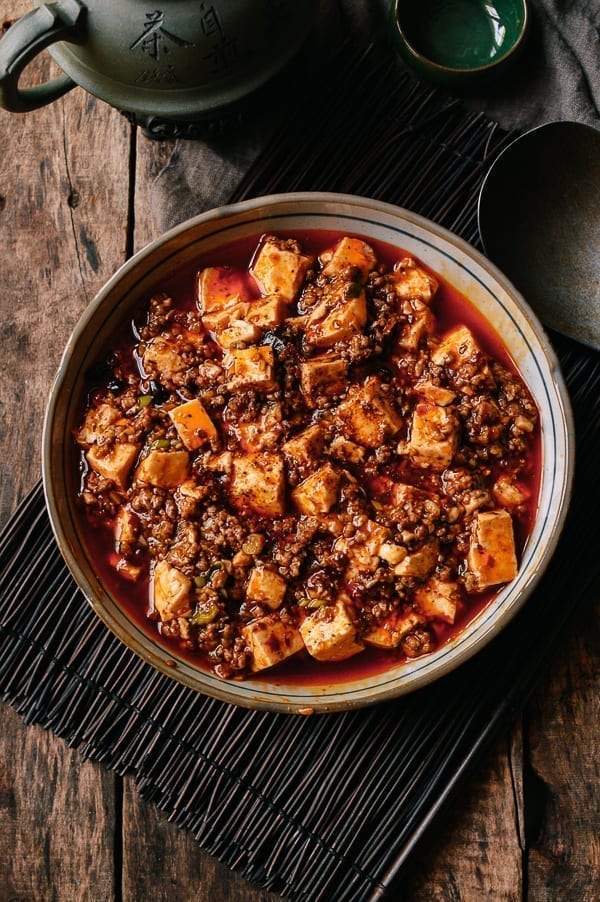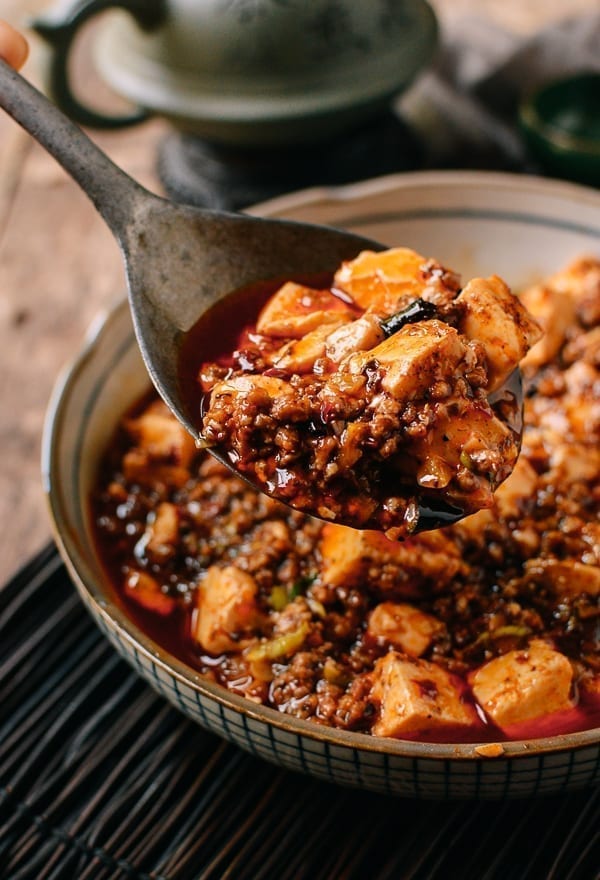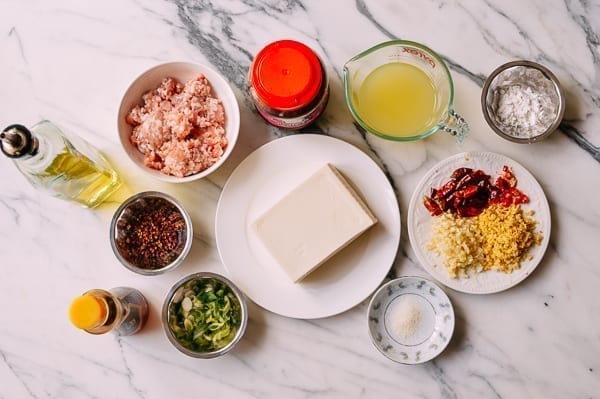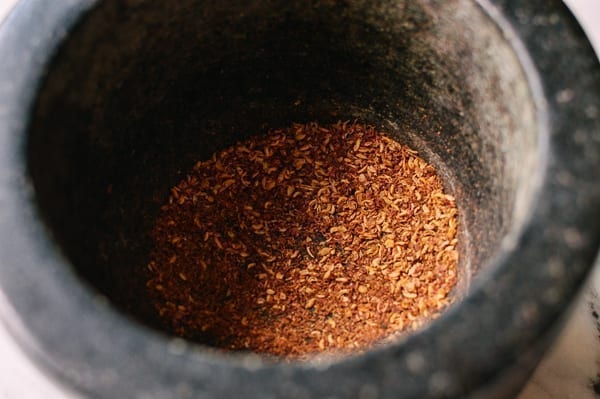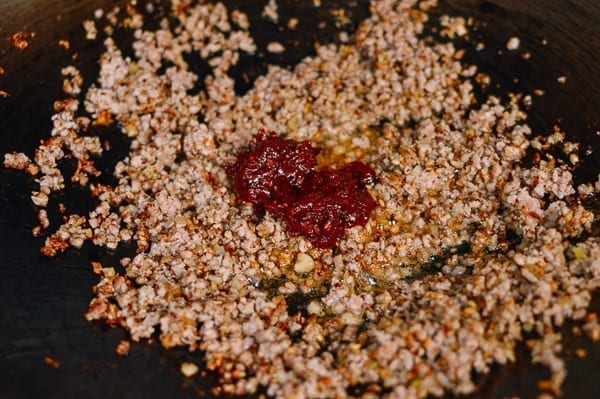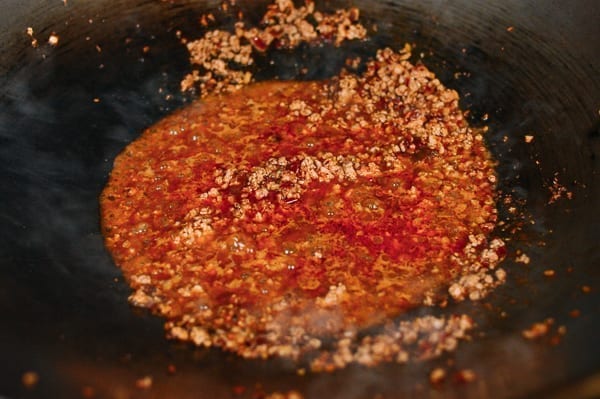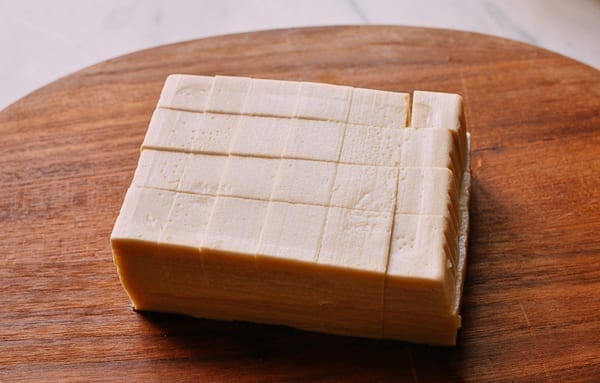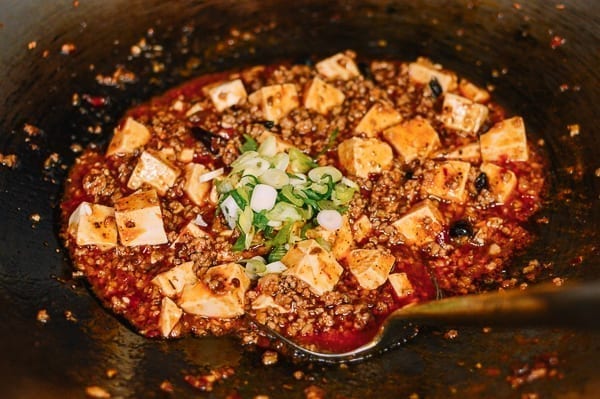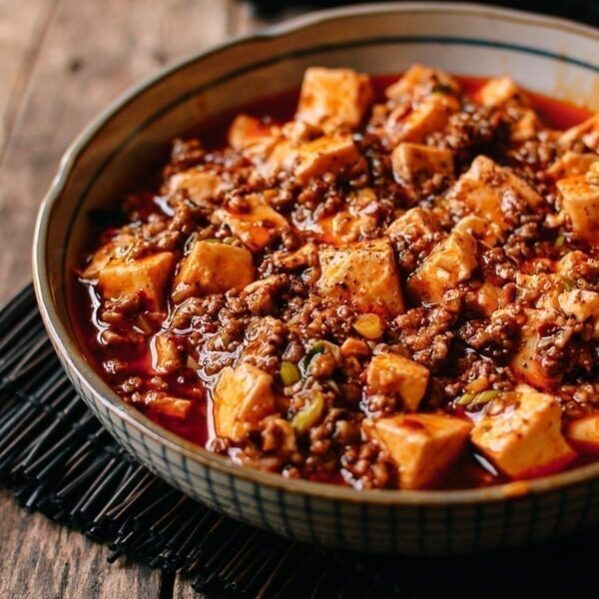Since we published this recipe in March 2014, it has garnered many 5-star reviews from readers! As of June 2019 , we’ve re-tested and updated the recipe with new photos, clearer instructions, a recipe video, and nutrition info.
What is Mapo Tofu?
Mapo Tofu is a popular Chinese dish from Sichuan Province, where spicy food is king and the signature spice of the region––the Sichuan Peppercorn––gives dishes a unique “numbing” effect. It’s almost like the Sichuan peppercorns are there to not only add their fragrance and flavor, but also to numb your tongue so it can take more heat! The name of the dish roughly translates to “pockmarked grandma’s tofu.” Whatever its origins, mapo tofu has made it out of Sichuan Province and spread around the world. The dish has taken on many forms as restaurants and takeout joints have put their own spin on it, often lessening spice levels, adding different vegetables, and transforming the dish into something else entirely! Traditional and authentic Sichuan mapo tofu is what we’re going for in this recipe. The spicy sauce coats the soft cubes of silken tofu, tasty bits of ground pork, scallion, and Sichuan (or Szechuan) peppercorns.
Getting That Restaurant Taste At Home
I know as well as the next foodie how difficult it can be to approximate restaurant-favorites at home, so if you’ve never tried one of our recipes, you may be thinking, “what a load of panda poop! Is this just another so-called ‘authentic’ dish?” Not so my friends—we don’t play around at The Woks of Life. If we say authentic, you better betchyo pineapple buns that it’s gonna turn out authentic. Plus, the backstory of this recipe says it all. It was the summer after my freshman year of college, and I was spending it in Beijing with my parents and sister. It was a hot and smoggy day, which meant “rainy day” activities that didn’t require venturing out into the noxious Beijing air. I was parked in my parents’ bedroom, flipping through the channels of countless historical dramas (you can literally go through ten straight channels, and each time the screen changes, you’ll see actresses in traditional dress, fighting back tears in disturbingly clear HD), Chinese nature documentaries (run little deer, ruuuun!), and mindless extended infomercials for the best Chinese dried dates you’ll ever taste, or your money back guaranteed (…or not). Anyways, I was knocked out of my stupor when my limited Chinese vocabulary was able to detect that the latest cooking program I had settled on was featuring a professional chef explaining how to make Mapo Tofu the right way. For the next 2 minutes, my eyes were glued to the screen, brain straining to understand just what the heck he was saying. Right after it was over, I scrambled to find a pen and paper to write down what I had seen and heard. After that and much testing/consulting with my family’s taste buds, here’s the finished product!
Adjusting the Recipe
Feel free to adjust this recipe to your own preferences. While we worked on making this recipe as close to what is served in Sichuan restaurants across China and here in New York, recipes can be deeply personal and therefore adjusted to your liking. That said, while the amounts can be adjusted, some ingredients are non-negotiable, like the Sichuan Peppercorns and the Spicy Bean Sauce (Doubanjiang). That said, the fresher the peppercorns, the more powerful their numbing effect will be. If your peppercorns are extremely fresh or high quality, you should consider reducing the amount of peppercorns within the range we call for in this recipe according to your own tastes! What’s more, some folks over the years complain of bitterness. I’ve realized over the years that the reason is threefold: You’ve all spoken and we’ve heard! Consider yourselves informed! Now, let’s say that the wok fire is off and you’ve plated your dish, you forgot to do a taste test, and you’re disappointed that you’ve been overly conservative with your Sichuan peppercorn! Sprinkle some extra over the top and stir it in for a quick fix. We call for it as a garnish, but there’s no reason why you can’t use it at your discretion too. The Mala Market is a great resource for authentic, premium Sichuan (and other Chinese) ingredients. They offer a Pixian Doubanjiang sourced and packaged for them in Sichuan, as well as a super premium 3-year aged Pixian Doubanjiang. You’ll also find premium Sichuan Peppercorns in their shop.
Mapo Tofu Recipe Instructions
(Scroll down to the recipe card for the full list of ingredients!) First, we toast the chilies. If you have homemade toasted chili oil, you can skip this step. Heat your wok or a small saucepan over low heat. Add ¼ cup of the oil and throw in the fresh and dried peppers. Stir occasionally and heat until fragrant, about 5 minutes, ensuring that the peppers don’t burn. Remove from heat and set aside. Heat the remaining ¼ cup of oil in your wok over medium heat. Add the ginger. After 1 minute, add the garlic. Fry for another minute, and then turn up the heat to high and add the ground pork. Break up the meat and fry it until it’s cooked through. Add the ground Sichuan peppercorns. Add the spicy bean sauce to the mixture… And stir it in well. You’ll see the color change! Add ⅔ cups of chicken broth to the wok and stir. Let this simmer for a minute or so. While that’s happening, ready your tofu and also put a ¼ cup of water in a small bowl with your cornstarch and mix until thoroughly combined. Add the cornstarch mixture to your sauce and stir. Let it bubble away until the sauce starts to thicken. (If it gets too thick, splash in a little more water or chicken stock.) For more detailed information on the many ways to use cornstarch to get authentic results at home with our recipes, see our post on How to Use Cornstarch in Chinese Cooking. Then add your chili oil from before—peppers and all! If you are using homemade chili oil, ONLY use the standing oil, as it’s likely that you have salted it and you only want the oil, not additional salt. Stir the oil into the sauce, and add the tofu. Use your spatula to gently toss the tofu in the sauce. Let everything cook for 3-5 minutes. Add the sesame oil and sugar (if using) along with the scallions and stir until the scallions are just wilted. Serve with a last sprinkle of Sichuan peppercorn powder as a garnish if desired. And your Ma Po Tofu is done! (If you laughed at that, we should definitely be friends.) When you make this for friends and family, I guarantee that they’ll ooh and ahh over how much this Mapo Tofu looks and tastes just like what your favorite Szechuan/Sichuan restaurant makes. We sure did! And you’ll be surprised at how simple it actually is. The key is to prep everything before you actually start cooking.
Watch The Video!
